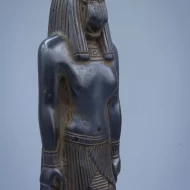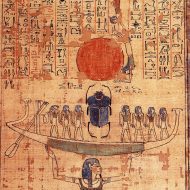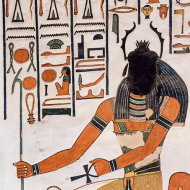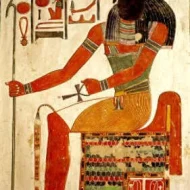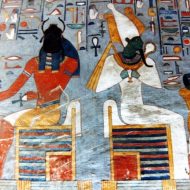Khepri : The Sun God
Listen
At a glance
| Description | |
|---|---|
| Origin | Egyptian Mythology |
| Classification | Gods |
| Family Members | Nut (Mother), Ma’at (Daughter), Shu (Son) |
| Region | Egypt |
| Associated With | Creation, Sun |
Khepri
Introduction
The scarab beetle, also known as the Kheper, Chepri, and Khepera, was associated with the Egyptian deity Khepri. During the time of the Egyptians, the scarab beetle would roll its manure into a ball and push it toward its burrow. The solar connection was made more prominent by the scarab’s antenna, which was placed on its head. When the scarab threw a ball of dung toward the ground, it would nestle between the antenna and a pair of horns, which resembled the horns worn by deities.
Although there was no cult of Khepri, he was regarded as a solar deity who was associated with Ra. In most temples, he is depicted as a scarab beetle or an individual who has a scarab beetle on his head. During the mummification process, the Egyptians would place amulets of the deity inside their bodies.
Physical Traits
Although most of the time, he was depicted as a scarabaus sacer scarab beetle, some tomb paintings and papyri depicted him as a human male, or a scarab with a head emerging from its shell. In a solar barque, Nun depicted him as a scarab. Archaeological finds have revealed that the Egyptians made amulets out of scarabs, which are often carved into seals and jewelry.
Family
It’s believed that the Khepri came into being as a scarab beetle that emerged from its fully formed ball of dung. The ancient Egyptians believed that scarabs could sense the movement of the sun by rolling their excrement on the sand. Since he was considered to be below Ra in the solar deity hierarchy, a shrine was not built for him. Other sun-gods such as Atum and Khepi are often regarded as part of Ra. The Book of The Dead states that Khepri was sometimes considered to be a member of Atum.
Khepri was the emerging sun, Nefertum was the new born sun, Ra was the sun during the day, and Atum was the setting sun. in later funerary texts, Atum and Khepri merged into a ram-headed beetle who was the ultimate expression of the power of life over death. Some myths believe that Khepri came from Nun, who created the universe. In another variation, it was Re who initiated the universe in its present form. After he had sexual relations with his own shadow and fathered Tefnut, who was the goddess of moisture, and Shu, who was an air god, the other gods descended on them.
Other names
Most of the time, the name Khepri appears in the Pyramids. It has a scarab hiegraph that is usually interpreted as a ideogram or a determinative. The term “Kheper,” which means sun god, scarab beetle, or verb to come into existence, can also be used to refer to the deity. Khepri is also known as Khepera, Kheper, Khepra and Chepri.
Powers and Abilities
The Egyptians regarded the scarab beetle as a significant animal because it laid eggs. When the ball of manure was rolled into its hole, it would push it across the sand and into a place where the eggs would hatch. The activity of the beetle, which was similar to a sun disk moving across the sky, became the symbol of Khepri. The scarab was associated with various traits, such as protection, rebirth, transformation, and birth. Scarab beetles were highly regarded during ancient Egypt. People did not kill them out of concern that it would harm Khepri. Instead, they were buried with scarab-shaped decorations and emblems. The purpose of this was to represent balance and justice.
The rising sun is believed to have emerged from the darkness and entered life and light as it repeats its daily cycle following the morning after. As a symbol of renewal, rejuvenation, and rebirth, Khepri is seen as the embodiment of this journey. During sunset, the sun disk pushed by the scarab beetle would move across the sky as part of its life cycle. At dawn, the sun disk pushed by the scarab beetle would continue moving across the sky.
Modern Day Influence
Although he played a significant role in Egyptian mythology and religion, Khepri was never worshipped at a temple. Instead, he was regarded as a manifestation of Ra, the sun-god. On the other hand, the scarab beetle was a widely-used religious symbol and a lot of modern Egyptian themed jewellery and art uses Khepri as a core element.
Related Images
Frequently Asked Questions
What is lorem Ipsum?
I am text block. Click edit button to change this text. Lorem ipsum dolor sit amet, consectetur adipiscing elit. Ut elit tellus, luctus nec ullamcorper mattis, pulvinar dapibus leo.
What is lorem Ipsum?
I am text block. Click edit button to change this text. Lorem ipsum dolor sit amet, consectetur adipiscing elit. Ut elit tellus, luctus nec ullamcorper mattis, pulvinar dapibus leo.
What is lorem Ipsum?
I am text block. Click edit button to change this text. Lorem ipsum dolor sit amet, consectetur adipiscing elit. Ut elit tellus, luctus nec ullamcorper mattis, pulvinar dapibus leo.
What is lorem Ipsum?
I am text block. Click edit button to change this text. Lorem ipsum dolor sit amet, consectetur adipiscing elit. Ut elit tellus, luctus nec ullamcorper mattis, pulvinar dapibus leo.
What is lorem Ipsum?
I am text block. Click edit button to change this text. Lorem ipsum dolor sit amet, consectetur adipiscing elit. Ut elit tellus, luctus nec ullamcorper mattis, pulvinar dapibus leo.

